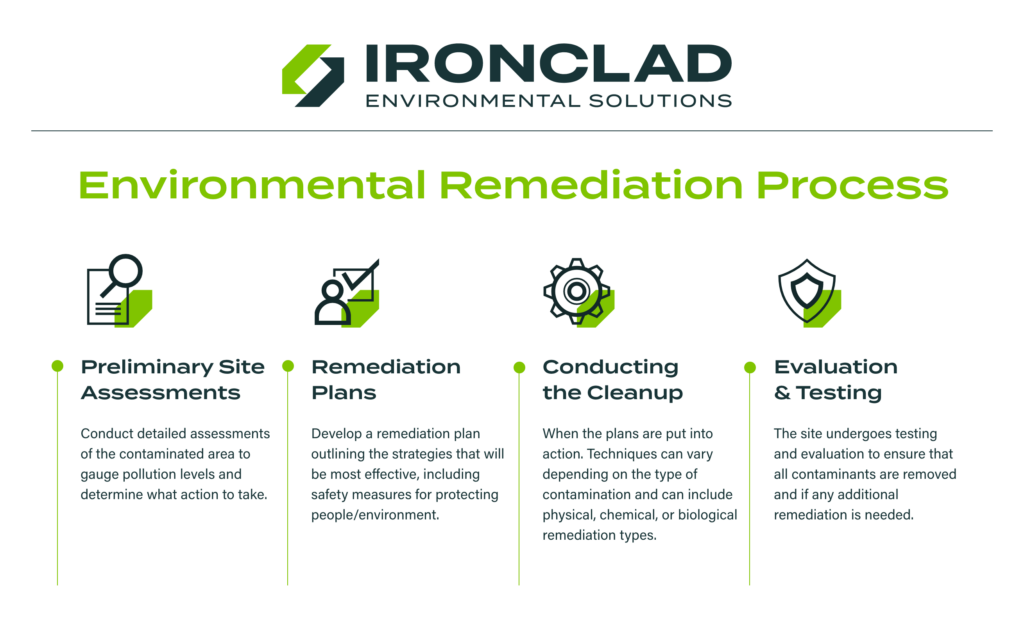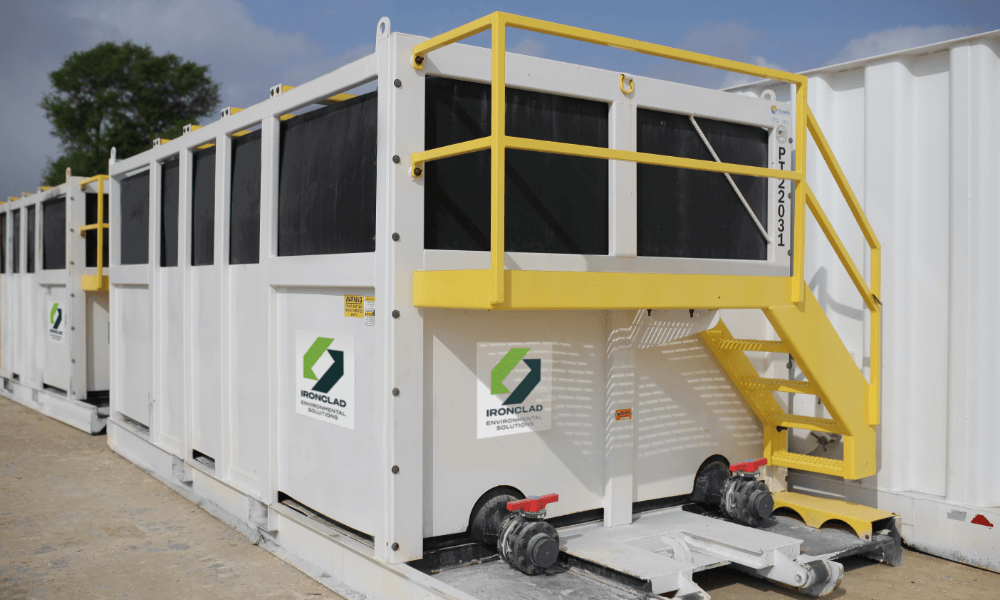Protecting the Environment with Environmental Remediation
Short Answer: Environmental remediation is the process of removing pollutants and contaminants from soil, groundwater, sediment, or surface water, which is essential for protecting human health from the harmful effects of pollution. This process helps maintain safe, sustainable environments for the future.
Why Environmental Remediation Matters
Hazardous waste sites present significant risks to people’s health and the environment, and exposure to those toxic chemicals can lead to a range of health issues. Environmental remediation addresses these threats by removing contaminants before they can cause harm.
The effectiveness of the remediation process extends beyond protecting public health; it also helps restore the balance and functionality of ecosystems.
Types of Environmental Remediation
Remediation encompasses various methods that address contaminants in different environmental media — soil, surface water, groundwater, sediments, contaminated buildings, structures, and/or equipment. Each type of remediation uses specific techniques to effectively treat and restore the affected areas.
Soil Remediation
Soil contamination, often stemming from industrial activities, agricultural chemicals, leaking underground storage tanks, or incorrect waste disposal, can adversely affect human, plant, and animal health. Remediation techniques include:
- Physical remediation
- Includes techniques like soil replacement, isolation, vitrification, and electrokinetic. Physical remediation can also involve washing or volatilization to remove contaminants and reduce volume.
- Chemical remediation
- Uses chemical reagents to treat soil and groundwater. Some chemical remediation techniques include immobilization, soil washing, in-situ chemical oxidation (ISCO), and in-situ chemical reduction (ISCR). Chemical oxidation can be useful for oil-contaminated soil because it’s non-selective and can contain the contaminant.
- Biological remediation
- Uses microorganisms to break down hydrocarbons. This environmentally friendly and cost-effective technique is called bioremediation. Other biological remediation techniques include photoevaporation, phytoextraction, and phytostabilization. Phytoremediation is a promising green technique that uses plant processes to remove contaminants or reduce their bioavailability.
Surface Water Remediation
Surface water contamination poses immediate risks to humans and the environment because it is easily accessible and can spread pollutants quickly. Remediation methods include directly removing or converting materials into harmless compounds. Some techniques for remediating surface water:
- Bioremediation
- Uses microorganisms or plants to remove pollutants from surface water, groundwater, and soil. Microorganisms can also detoxify metals through bioleaching, biomineralization, biosorption, and bioreduction.
- Biodegradation
- Removes pollutants and contaminants from surface water, groundwater, sediments, soil, and air to reduce the risk to human health and the environment.
- Interceptor systems
- Also known as grease traps or oil water separators, these systems prevent pollution from hydrocarbons like diesel and oil from entering the water supply.
- In situ soil flushing
- Injects a water solution into the subsoil to remove contaminants from the soil. The water dissolves the contaminants and carries them to wells where the mixture is collected and then pumped out and treated.
- Phytobiological remediation
- Uses plants and bacteria to remove heavy metals from water and soil. This method is cost-effective and environmentally friendly.
- Pump and treat
- Directly pumps contaminated groundwater or free-phase contaminants from the surface
Groundwater Remediation
Contaminated groundwater can result from leaks from landfills, industrial oil spills, and agricultural runoff. Remediation strategies involve a combination of chemical, physical, and biological treatments to remove pollutants. The ultimate goal is to improve water quality and minimize its negative impact on the environment. Some groundwater remediation techniques:
- Bioremediation
- A versatile technique that can break down organic contaminants into less harmful compounds, and modify metals to reduce their toxicity and mobility
- In situ chemical oxidation (ISCO)
- Uses chemical oxidants to destroy contaminants in soil and groundwater
- In situ treatments
- An emerging technology that can remediate soil and groundwater on site, reducing costs associated with removal and disposal
- Pump and treat
- Uses pumps to remove contaminated groundwater from soil, and then remediate it at the surface
- Soil washing
- Uses chemical reagents to leach contaminants from soil, and can be done in situ or ex situ
- Air sparging
- Injects air into a contaminated area, causing semivolatile and volatile contaminants to transfer mass
- Soil vapor extraction
- Injects air or steam into the ground using blowers and injection wells, and then extracts and treats the vapors
- Permeable reactive barriers (PRB)
- Digs a trench in the path of flowing groundwater and fills it with a permeable reactive material
- Chemical remediation
- Uses various chemical reagents, and is considered an effective technique for dealing with different contaminants
Sediment Remediation
According to the Environmental Protection Agency (EPA), sediment is formed when water, soil, and sand combine at the bottom of water bodies. Common remediation methods for contaminated sediment include:
- Dredging: Removing contaminated sediment from a body of water without draining or diverting the water.
- In-Situ Capping: Placing layers of clean material on top of the sediment to isolate the contaminants.
- Monitored Natural Recovery: Allowing natural processes to remove the toxic materials from the contaminants by leaving them in situ.
Each of these methods plays an important role in mitigating environmental risks and ensuring the health and safety of our local communities and ecosystems.
How Environmental Remediation Works
Environmental remediation is a comprehensive process that addresses and mitigates the impact of contaminants on the environment.
The Four Stages
The remediation process is broken down into four main steps:

Environmental Site Assessments
The initial step in remediation involves a thorough assessment of the contaminated area. Professionals conduct detailed investigations to identify the types of contamination. They will collect soil and groundwater samples to accurately gauge the pollution levels and determine the appropriate remediation measures to take.
Remediation Plans
Based on the findings from the preliminary assessments, experts will develop a remediation plan. This plan outlines the strategies and technologies that will be most effective for treating the specific pollutants found at the site. The plan also includes safety measures for protecting workers and the public during cleanup operations.
Conducting the Cleanup
The cleanup phase is when the planned methods are put into place. Techniques can vary depending on the type of contamination and may include physical, chemical, or biological remediation methods. Throughout this stage, it’s important to adhere to regulatory and safety standards to ensure the most effective removal or neutralization of materials.
Evaluation and Testing
After the cleanup process, the site undergoes rigorous testing and evaluation to ensure that all contaminants have been removed and that the site is restored to safe conditions. This last step can involve repeated testing or additional remediation to monitor the long-term viability of the project’s efforts.
The Involvement of Remediation Tanks
Remediation tanks are valuable pieces of equipment used in this process. Their purpose is to safely contain and transport contaminated materials or temporarily store them during the cleanup to prevent any leaks or spills.
The ultimate goal of environmental remediation is this — preventing the spread of hazardous substances, toxic chemicals, and other contaminants into the environment. It ensures that contaminants are controlled at the source, reducing the risk of pollution spreading to unaffected areas.

More In-Depth: The Role of Tanks used in Remediation
Frac tanks (liquid storage tanks) and roll-off boxes are secondary containment solutions designed to manage and isolate the waste generated during the execution of environmental remedial activities. In environmental remediation projects, the ability to securely store hazardous materials is critical.
- Steel Frac Tanks: Ideal for storage of water, chemicals, and other liquids.
- Roll-Off Boxes: Best used for storage of solid waste and hazardous materials.
These assets are used in various applications, including sediment suspension, sludge dewatering, chemical storage, etc. They are also essential in environmental cleanup operations and for the safe storage of hazardous waste during and after the remediation process.
Benefits of High-Quality, Durable Secondary Containment Equipment
Investing in high-quality assets is essential for improving the safety and efficiency of remedial activities. The benefits of these containment solutions include:
- Withstands harsh environmental conditions
- Resists the corrosive effects of the chemicals and materials they store
- Durability minimizes the risk of leaks or spills
- Ensures continuous operation of projects without interruptions
- Exceeds safety standards and compliance with environmental regulations
By effectively isolating hazardous materials, we can ensure that remediation projects lead to positive outcomes for the environment and public health.

Choosing the Right Remediation Partner
Working with an experienced and reliable company that can assist in your remediation projects is crucial. The right partner not only brings expertise but also ensures that the complexities of such projects are handled professionally. An experienced company can navigate the regulatory process, employ the most effective practices, and mitigate potential risks.
That’s where Ironclad Environmental comes into play, a leader in specialty containment and equipment service support to the environmental remediation service industry. With nearly four decades of expertise, we offer an extensive fleet of assets and a commitment to safety and environmental standards. Our team addresses the unique challenges of each site, ensuring that remediation efforts are thorough, compliant, and effective.
Our Assets: Frac Tanks & Roll-Off Boxes
Specific assets like our steel tank rentals (commonly known as frac tanks) and roll-off box rentals are ideal for projects involving liquid storage and solid waste management. We tailor our solutions to meet the needs of diverse industries, including refining, manufacturing, construction, pipelines, and municipal services.
Whether it’s contaminated groundwater or flooding on your site, our team is here to handle waste materials safely and efficiently. Contact Ironclad Environmental today and find the solution you’ve been looking for!
Resources:
- Environmental Protection Agency. https://www.epa.gov/
- Ironclad Environmental. https://ironcladenvironmental.com/